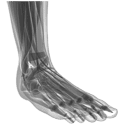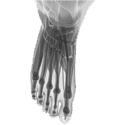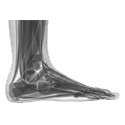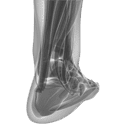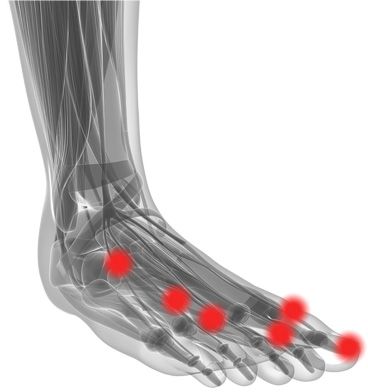
Where does it hurt?
Click on any area of the foot to learn more.
Ganglion Cyst
A ganglion cyst is a mass of tissue that is filled with a jellylike fluid. The word “ganglion” means “knot” and is used to describe the knot-like mass or lump of cells that forms below the surface of the skin. Ganglion cysts are among the most common benign soft-tissue masses.
Toe and Metatarsal Fractures
The structure of your foot is complex, consisting of bones, muscles, tendons, and other soft tissues. Of the 26 bones in your foot, 19 are toe bones (phalanges) and metatarsal bones (the long bones in the midfoot). Fractures of the toe and metatarsal bones are common and require evaluation by a specialist.
Morton’s Neuroma
A neuroma is a thickening of nerve tissue that may develop in various parts of the body. The most common neuroma in the foot is a Morton’s neuroma, which occurs at the base of the third and fourth toes. It is sometimes referred to as an intermetatarsal neuroma. “Intermetatarsal” describes its location—in the ball of the foot between the metatarsal bones (the bones extending from the toes to the midfoot).
Hammertoe
Hammertoe is a contracture— or bending—of one or both joints of the second, third, fourth, or fifth (little) toes. This abnormal bending can put pressure on the toe when wearing shoes, causing problems to develop.
Crossover Toe
Crossover toe is a condition in which the second toe drifts toward the big toe and eventually crosses over and lies on top of the big toe. Crossover toe is a common condition that can occur at any age, although it is most often seen in adults. Some people confuse crossover toe with a hammertoe, probably because both conditions involve a toe that does not lie in the normal position.
Gout
Gout is a disorder that results from the build-up of uric acid in the tissues or a joint—most often the joint of the big toe.
Bunions
Bunions are often described as a bump on the side of the big toe. But a bunion is more than that. Even though bunions are a common foot deformity, there are misconceptions about them. Many people may unnecessarily suffer the pain of bunions for years before seeking treatment.The visible bump actually reflects changes in the bony framework of the front part of the foot.
Ingrown Toenail
When a toenail is ingrown, the nail is curved downward and grows into the skin, usually at the nail borders (the sides of the nail). This “digging in” of the nail irritates the skin, often creating pain, redness, swelling, and warmth in the toe. If an ingrown nail causes a break in the skin, bacteria may enter and cause an infection in the area, which is often marked by drainage and a foul odor.
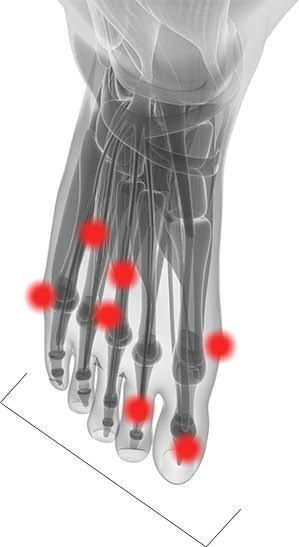
Where does it hurt?
Click on any area of the foot to learn more.
Tailor’s Bunions
Tailor’s bunion, also called a bunionette, is an enlargement of the fifth metatarsal bone at the base of the little toe. The metatarsals are the five long bones of the foot. The enlargement that characterizes a tailor’s bunion occurs at the metatarsal “head,” located at the far end of the bone where it meets the toe. Tailor’s bunions are not as common as bunions, which occur on the inside of the foot, but both are similar in symptoms and causes.
Morton’s Neuroma
A neuroma is a thickening of nerve tissue that may develop in various parts of the body. The most common neuroma in the foot is a Morton’s neuroma, which occurs at the base of the third and fourth toes. It is sometimes referred to as an intermetatarsal neuroma. “Intermetatarsal” describes its location—in the ball of the foot between the metatarsal bones (the bones extending from the toes to the midfoot).
Bunion
Bunions are often described as a bump on the side of the big toe. But a bunion is more than that. Even though bunions are a common foot deformity, there are misconceptions about them. Many people may unnecessarily suffer the pain of bunions for years before seeking treatment.The visible bump actually reflects changes in the bony framework of the front part of the foot.
Gout
Gout is a disorder that results from the build-up of uric acid in the tissues or a joint—most often the joint of the big toe. Each day, with every step you take, your big toe bears a tremendous amount of stress—a force equal to about twice your body weight. Most of us don’t realize how much we use our big toe. We tend to take it for granted, unless a problem develops. One problem that afflicts the big toe is called hallux
rigidus, a condition where movement of the toe is restricted to varying degrees.
Hallux Rigidus
Each day, with every step you take, your big toe bears a tremendous amount of stress—a force equal to about twice your body weight. Most of us don’t realize how much we use our big toe. We tend to take it for granted, unless a problem develops. One problem that afflicts the big toe is called hallux
rigidus, a condition where movement of the toe is restricted to varying degrees.
Ingrown Toenail
When a toenail is ingrown, the nail is curved downward and grows into the skin, usually at the nail borders (the sides of the nail). This “digging in” of the nail irritates the skin, often creating pain, redness, swelling, and warmth in the toe. If an ingrown nail causes a break in the skin, bacteria may enter and cause an infection in the area, which is often marked by drainage and a foul odor.
Puncture Wounds
Puncture wounds and cuts are not the same. A puncture wound has a small entry hole caused by a pointed object — for example, a nail that you step on. In contrast, a cut is an open wound that doesn’t produce a “hole” but rather a long tear in the skin. Puncture wounds require different treatment from cuts because these small holes in the skin can
disguise serious injury.
Ganglion Cyst
Aganglion cyst is a mass of tissue that is filled with a jellylike fluid. The word “ganglion” means “knot” and is used to describe the knot-like mass or lump of cells that forms below the surface of the skin. Ganglion cysts are among the most common benign soft-tissue masses.
Metatarsal Fratures
The structure of your foot is complex, consisting of bones, muscles, tendons, and other soft tissues. Of the 26 bones in your foot, 19 are toe bones (phalanges) and metatarsal bones (the long bones in the midfoot). Fractures of the toe and metatarsal bones are common and require evaluation by a specialist.
Hammertoe
Hammertoe is a contracture— or bending—of one or both joints of the second, third, fourth, or fifth (little) toes. This abnormal bending can put pressure on the toe when wearing shoes, causing problems to develop.
Crossover Toe
Crossover toe is a condition in which the second toe drifts toward the big toe and eventually crosses over and lies on top of the big toe. Crossover toe is a common condition that can occur at any age, although it is most often seen in adults. Some people confuse crossover toe with a hammertoe, probably because both conditions involve a toe that does not lie in the normal position.
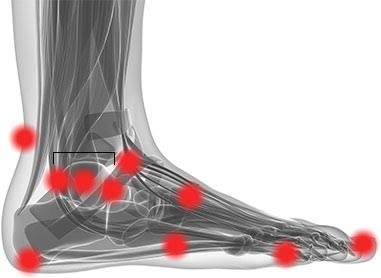
Where does it hurt?
Click on any area of the foot to learn more.
Achilles Tendon
The Achilles tendon—the longest tendon in the body—runs down the back of the lower leg and connects the calf muscle to the heel bone. Also called the “heel cord,” the Achilles tendon facilitates walking by helping to raise the heel off the ground. Achilles Tendonitis and Achilles Tendonosis Two common disorders that occur in the heel cord are Achilles tendonitis and Achilles tendonosis. Achilles tendonitis is an inflammation of the Achilles tendon. This inflammation is typically short-lived.
Peroneal Tendons
A tendon is a band of tissue that connects a muscle to a bone. In the foot, there are two peroneal tendons. They run side-by-side behind the outer ankle bone. One peroneal tendon attaches to the outer part of the
midfoot, while the other tendon runs under the foot and attaches near the inside of the arch.
Ankle Fractures
A fracture is a partial or complete break in a bone. In the ankle, fractures can range from the less serious avulsion injuries (small pieces of bone that have been pulled off) to severe shattering-type breaks of the tibia, fibula, or both. Ankle fractures are common injuries that are most often caused by the ankle rolling inward or outward.
Ankle Sprain
An ankle sprain is an injury to one or more ligaments in the ankle, usually on the outside of the ankle. Ligaments are bands of tissue—like rubber bands—that connect one bone to another and bind the joints together. In the ankle joint, ligaments provide stability by limiting side-to-side movement. Some ankle sprains are much worse than others.
Chronic Ankle Instability
Chronic ankle instability is a condition characterized by a recurring “giving way” of the outer (lateral) side of the ankle. This condition often develops after repeated ankle sprains.
PTTD
Posterior tibial tendon dysfunction (PTTD) is an inflammation and/or overstretching of the posterior tibial tendon in the foot. An important function of the posterior tibial tendon is to help support the arch. But in PTTD, the tendon’s ability to perform that job is impaired, often resulting in a flattening of the foot. The posterior tibial tendon is a fibrous cord that extends from a muscle in the leg. It descends the leg and runs along the inside of the ankle, down the side of the foot, and into the arch.
Osteoarthritis
Osteoarthritis is a condition characterized by the breakdown and eventual loss of cartilage in one or more joints. Cartilage—the connective tissue found at the end of the bones in the joints—protects and cushions the bones during movement. When cartilage deteriorates or is lost, symptoms develop that can restrict one’s ability to easily perform daily activities. Osteoarthritis is also known as degenerative arthritis, reflecting its nature to develop as part of the aging process.
Ganglion Cyst
A ganglion cyst is a mass of tissue that is filled with a jellylike fluid. The word “ganglion” means “knot” and is used to describe the knot-like mass or lump of cells that forms below the surface of the skin. Ganglion cysts are among the most common benign soft-tissue masses. Although they most often occur on the wrist, they also frequently develop on the foot— usually on the top, but elsewhere as well.
Ingrown Toenail
When a toenail is ingrown, the nail is curved downward and grows into the skin, usually at the nail borders (the sides of the nail). This “digging in” of the nail irritates the skin, often creating pain, redness, swelling, and warmth in the toe. If an ingrown nail causes a break in the skin, bacteria may enter and cause an infection in the area, which is often marked by drainage and a foul odor.
Hammertoe
Hammertoe is a contracture— or bending—of one or both joints of the second, third, fourth, or fifth (little) toes. This abnormal bending can put pressure on the toe when wearing shoes, causing problems to develop.
Flexible Flatfoot
Flatfoot is often a complex disorder, with diverse symptoms and varying degrees of deformity and disability. There are several types of flatfoot, all of which have one characteristic in common—partial or total collapse (loss) of the arch.
Heel Pain
Heel pain is most often caused by plantar fasciitis—a condition that is sometimes also called heel spur syndrome when a spur is present. Heel pain may also be due to other causes, such as a stress fracture, tendonitis, arthritis, nerve irritation, or, rarely, a cyst. Because there are several potential causes, it is important to have heel pain properly diagnosed. A podiatric foot and ankle surgeon is best trained to distinguish between all the possibilities and determine the underlying source of your heel pain.
Tarsal Tunnel
The tarsal tunnel is a narrow space that lies on the inside of the ankle next to the ankle bones. The tunnel is covered with a thick ligament (the flexor retinaculum) that protects and maintains the structures contained within the tunnel—arteries, veins, tendons, and nerves. One of these structures is the posterior tibial nerve, which is the focus of tarsal tunnel syndrome.

Where does it hurt?
Click on any area of the foot to learn more.
Heel Pain
Heel pain is most often caused by plantar fasciitis—a condition that is sometimes also called heel spur syndrome when a spur is present. Heel pain may also be due to other causes, such as a stress fracture, tendonitis, arthritis, nerve irritation, or, rarely, a cyst. Because there are several potential causes, it is important to have heel pain properly diagnosed. A podiatric foot and ankle surgeon is best trained to distinguish between all the possibilities and determine the underlying source of your heel pain.
Haglund’s Deformity
Haglund’s deformity is a bony enlargement on the back of the heel that most often leads to painful bursitis, which is an inflammation of the bursa (a fluid-filled sac between the tendon and bone). In Haglund’s deformity, the soft tissue near the Achilles tendon becomes irritated when the bony enlargement rubs against shoes. Haglund’s deformity is often called “pump bump” because the rigid backs of pump-style shoes can create pressure that aggravates the enlargement when walking.
Achilles Tendon
The Achilles tendon—the longest tendon in the body—runs down the back of the lower leg and connects the calf muscle to the heel bone. Also called the “heel cord,” the Achilles tendon facilitates walking by helping to raise the heel off the ground. Achilles Tendonitis and Achilles Tendonosis Two common disorders that occur in the heel cord are Achilles tendonitis and Achilles tendonosis. Achilles tendonitis is an inflammation of the Achilles tendon. This inflammation is typically short-lived.
Peroneal Tendons
A tendon is a band of tissue that connects a muscle to a bone. In the foot, there are two peroneal tendons. They run side-by-side behind the outer ankle bone. One peroneal tendon attaches to the outer part of the midfoot, while the other tendon runs under the foot and attaches near the inside of the arch.
Flexible Flatfoot
Flatfoot is often a complex disorder, with diverse symptoms and varying degrees of deformity and disability. There are several types of flatfoot, all of which have one characteristic in common—partial or total collapse (loss) of the arch.
Osteoarthritis
Osteoarthritis is a condition characterized by the breakdown and eventual loss of cartilage in one or more joints. Cartilage—the connective tissue found at the end of the bones in the joints—protects and cushions the bones during movement. When cartilage deteriorates or is lost, symptoms develop that can restrict one’s ability to easily perform daily activities. Osteoarthritis is also known as degenerative arthritis, reflecting its nature to develop as part of the aging process.
Tailor’s Bunions
Tailor’s bunion, also called a bunionette, is an enlargement of the fifth metatarsal bone at the base of the little toe. The metatarsals are the five long bones of the foot. The enlargement that characterizes a tailor’s bunion occurs at the metatarsal “head,” located at the far end of the bone where it meets the toe. Tailor’s bunions are not as common as bunions, which occur on the inside of the foot, but both are similar in symptoms and causes.

